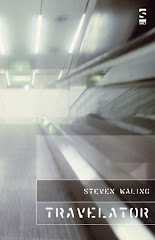I've been reading lots of anthologies recently. There's been a lot of them about, from Identity Parade to the new anthology of North-West Poets, Sculpted, only just out, beautifully packaged and full of poets from the North-West of England, including me. (Of course you all want one don't you?)
One thing I've noticed about all of them is that they all represent a fraction of what is happening, even given the restrictions they placed themselves under. Anthologies of young poets, for instance, that don't include so-and-so. Why don't they include who-je-ma-flip? But that's OK; because look, here they are in this anthology of young poets. This is true even of regional anthologies: I can think of a few poets missing from Sculpted, for instance, some who joined the group after the anthology was already in production or some who are not yet members of the group or might not want to be part of it.
Even an anthology of young often experimentally inclined poets such as Nathan Hamilton's Dear World and Everything In It, does not include every deserving experimental young poet in the country. If we can have Keston Sutherland, for instance, why not Sean Bonney? Or where is Richard Barrett? Etc... I'm sure there's people all over the country saying, where's she, or he?
Anthologies used to be representative of at least the best of the trends in poetry at the time, whether that was the mainstream as represented by the Movement-influenced Penguin Book of Contemporary British Poetry, or the more radical, Modernist influenced Conductors of Chaos. No anthology includes everybody; but pretty much anyone who you'd expect to see, plus a few surprises, tended to be in them all.
But there's so many poets writing now, that it's become impossible for one anthology to represent the whole scene. Perhaps it always was the case; and there have always been good poets who never got into the anthologies; but it's even more so now. Sculpted, with 62 poets, represents a fragment of what's being written now, and is worth reading, in the North-West region alone.
Which is all to the good, but no-doubt confusing. There are names that keep cropping up in many of the anthologies: Luke Kennard, Emily Berry, Ahren Warner and Heather Phillipson seem to be the names do jour of the present crop of young poets. No-one however is dominating in the way that Carol Anne Duffy and Simon Armitage did. One thing that is evident is that there is a spread of formal possibilities, from variations on traditional forms to the opennest of open forms (it that a word? It is now!) and they're all mixed up together in the one anthology, not cordonned off into their own corraal where they only ever speak to like minded individuals. In Sculpted, for instance, we have prose poetry, dual-column poetry and rhyme rubbing up against one another, arguing with one another, making friends with one another perhaps. It's not been like this since - maybe the Sixties (when according to Andrew Motion, nothing much was supposedly happening.)
I think there's two possibilities. Either we can get over the binary thinking that puts experimental and mainstream in two camps firing potshots at one another; or we can embrace the pluralism, get with the programme as it were. Poetry in this country is enjoying a renniasance, even if the media hasn't cottoned on yet.
A statement about my mother who has died
3 weeks ago

2 comments:
I love the diversity to be found in many anthologies. Poetry is too strong and too vibrant a creature to be confined by one yoke and a varied anthology is always a gift when we find ourselves reading a genre we would not naturally gravitate too. Vive la difference...
Halle-and furthermore-lujah. The (entirely arbitrary) division between "mainstream" and non-etc is a self defeating cloud of guff. There is a wealth of work out there, and the very idea of ghettoising texts based upon some nebulous concept of style means only those who have a good look around see even a fraction of it.
Post a Comment